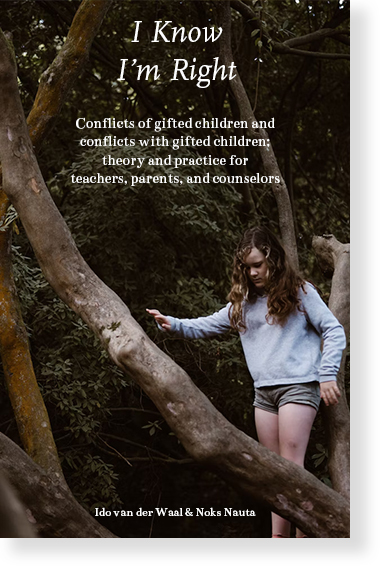
HOME | BOOKS | AUTHORS | GENRES | CONTACT
Ido van der Waal & Noks Nauta - I Know I'm Right
Conflicts of gifted children and conflicts with gifted children; theory and practice for teachers, parents, and counselors
Jump to: Book details | About the authors | Table of contents
 |
Many factors determine how conflicts are handled, such as culture, age, gender, etc., but also how we think. The gifted think quickly and complexly. Our practical experience and information from research shows that the gifted (more than average) are strongly guided in their opinion formed by their value system. This regularly exceeds their own interests.
For example, when perceiving injustice, gifted children can make choices that are even a threat to their own safety or an obstacle to their own education. An example of this is taking the side of the underdog in an argument with classmates or a serious disagreement with a teacher about lesson content. Because of this way of thinking and dealing with disagreements, there are many moments that can lead to clashes.
This book aims to create more awareness of the positive meaning of disagreements but also of the consequences of often unnecessarily escalated conflicts. And the book offers ways to learn from these situations and to prevent escalation and damage. The way gifted people handle conflict can be life defining at an early age.
The book provides several examples of situations where things have gone wrong or are at risk of going wrong. The authors outline various scenarios and indicate what parents and teachers of gifted children can do to come out of it on a positive note. It's about recognizing the behavior of others, becoming aware of one's own behavior and how this can be turned into an instructive dialogue. There are also tools to prevent situations from getting out of hand.
|
 |
Ido van der Waal is a mediator, an expert in conflicts and in conflict resolution, and former chair of the Association of Labor Mediators in The Netherlands (Vereniging Arbeidsmediators Nederland, VAN). He has mediated in hundreds of workplace conflicts, and has many years of experience in advising and coaching of gifted adults in conflicts and mediating in these conflicts. Ido has an innovative view on conflicts that goes beyond resolving them. He publishes and presents on labor conflicts and on conflicts of the gifted, and is currently active in conflict innovation.
Dr. Noks Nauta is an M.D. and psychologist, Ph.D., specializing in gifted adults. She has authored many articles and books, like Gifted Adults; Hitting the target (BigBusiness Publishers, 2016). She is the co-founder and honorary board member of the Gifted Adults Foundation in the Netherlands (www.IHBV.nl) and a regular speaker at national and international conferences.
Part I Why we wrote this book
1. Introduction
1.1 A case: Rosalind
1.2 Recognition worldwide
2. Motivation and the aim of this book
2.1 Personal motivation
2.2 Professional motivation
2.3 Aim of this book
2.4 Who will find this book useful?
2.5 Acknowledgment
Part II Theory
3. A brief theoretical background on giftedness and conflicts
3.1 Giftedness
3.2 Conflicts
3.3 Understanding giftedness and conflicts
4. Conflicts of the gifted
4.1 Introduction
4.2 Characteristics of giftedness and their role in the development of a conflict
4.3 Other insights related to giftedness and conflicts
4.4 Conflicts experienced by gifted adults at work
4.5 Conflicts involving gifted children
4.6. Patterns in conflicts
5. Dealing with conflicts and imminent conflicts
5.1 Coping
5.2 Principles of Rational Emotive Therapy
5.3 Communication
Part III Cases
6. Introduction to all cases
7. “But I know I’m right”
8. “I want to win“
9. “I just can’t collaborate with the others”
10. “I feel everything so intensely”
11. “I love asking questions”
12. “F... the rules”
13 “I really want to know all about it!”
14. “He’s a stupid director”
15. “But I know it’s a good idea!”
16. “A little bit of luck makes all the difference”
Part IV Implement knowledge
17. Introduction to implementation
18. Deliberation and plan for action
18.1 Introduction
18.2 Deliberation
19. Summary of the cases in chapters 7-16
20. Aspects of an effective dialogue
21. Topics for learning in classrooms and at home
Part V Appendices
Epilogue and points for discussion
References
Index
About the authors